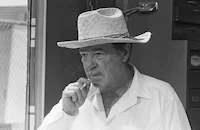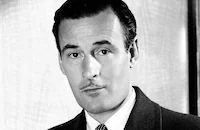The Falcon in Hollywood

Brief Synopsis
Cast & Crew
Gordon Douglas
Tom Conway
Barbara Hale
Veda Ann Borg
John Abbott
Sheldon Leonard
Film Details
Technical Specs

Synopsis
Tom Lawrence, the debonair sleuth known as "The Falcon," is vacationing in Los Angeles and meets Inspector McBride at the Hollywood Race Track. McBride asks Tom if he has seen casino owner Louie Buchanan, whom Tom helped imprison. After disavowing knowledge of Louie's whereabouts, Tom returns to his seat and finds Louie standing in the row behind his. Tom is seated next to actress Lili D'Allio, and when she leaves to make a bet, Peggy Callahan, Louie's girl friend, takes her spot. Peggy leaves when Lili returns and accidentally takes Lili's purse. In pursuit of Peggy, who is acting at the Sunset Studio, and the purse, Tom hails a cab driven by Billie, a woman stunt driver. They follow Peggy to the studio, where Tom hears a gun shot ring out in a deserted sound stage.
On the darkened set, Tom finds a corpse, but by the time the police arrive, the body is missing. After finding Peggy and Lili's purse, Billie and Tom resume their search for the missing body, which they find in the prop room. Billie identifies the deceased as leading man Ted Miles, who was married to Roxanna, the studio's costume designer. Tom summons Roxanna to the prop room, and she arrives with director Alec Hoffman. Confronted by her husband's dead body, Roxanna announces that she detested Ted and plans to marry Hoffman. Despite Tom's protests that he is on vacation and does not want to become involved in a murder investigation, Billie drives him to Ted's apartment where they find a photo of Peggy and a contract assigning Ted a twenty-five percent interest in Hoffman's next picture. McBride then arrives at the apartment and takes Tom and Billie back to the studio. At the studio, McBride questions Martin Dwyer, the Shakespeare-quoting producer in charge of Hoffman's film. Dwyer informs them that Ted demanded his investment in the picture back so that he could pay a gambling debt. As collateral, the producer gave him a ruby ring, which is now missing from Ted's possessions.
McBride next questions Hoffman, who contends that he was at the studio's miniatures department at the time of Ted's death. Tom visits that department, where he finds the murder weapon hidden in a plaster head. Dwyer cancels the picture when Hoffman is arrested for murder, but when McBride discovers that the murder weapon was registered to Dwyer, the producer insists that he had reported the gun stolen. With Hoffman's guilt now in doubt, Lili arranges for his release on bail and the picture resumes shooting on location at her pool. As the cameras record a scene in which Peggy fires a prop gun, the gun goes off and wounds Hoffman. While McBride questions the crew about the shooting, Tom finds Peggy and Louie in conference, and Louie promises to deliver the killer the next day.
The following day, Peggy drives Tom to meet Louie at the Los Angeles Coliseum, where Peggy informs Tom that Louie was also an investor in the picture. After Billie arrives in her cab, Louie stumbles from the stands and collapses, poisoned. Tom finds the ruby ring on Louie's finger, and when McBride arrives, he explains that the poison was fused in the ring, which injected it into the wearer's blood stream. When Tom concludes that Dwyer murdered Ted and Louie because he oversold his interest in the film, McBride arrests them all and drives them to Dwyer's office, where McBride confronts the producer with Tom's accusation. In response, Dwyer pulls a gun and escapes, but Billie and Tom chase him to a sound stage. There Tom wounds the producer in a shootout, thus apprehending the killer and solving the case.

Director

Gordon Douglas
Cast

Tom Conway

Barbara Hale

Veda Ann Borg

John Abbott

Sheldon Leonard
Konstantin Shayne
Emory Parnell
Frank Jenks

Jean Brooks

Rita Corday
Walter Soderling
Useff Ali
Robert Clarke
Carl Kent
Gwen Crawford
Patti Brill

Bryant Washburn
Sammy Blum
Greta Christensen
Margie Stewart
Virginia Belmont
Nancy Marlow
Chris Drake
Jimmy Jordan
George De Normand
Perc Launders
Jacques Lory
Chili Williams
Chester Clute
Wheaton Chambers
Bert Moorhouse
Tom Burton
Crew
C. Bakaleinikoff
Fred Bentley
James Casey
L. O. Croxton
Albert S. D'agostino
Lynn Dunn
Gerald Geraghty
Maurice Geraghty
Terry Kellum
Gene Milford
Nicholas Musuraca
Michael Ohrenbach
Theodore Rand
Renie
Sid Rogell
Francis M. Sarver
Darrell Silvera
Leslie Urbach
Vernon L. Walker

Film Details
Technical Specs

Articles
The Falcon in Hollywood -
By Glenn Erickson

The Falcon in Hollywood -
Quotes
Trivia
Notes
Although the Variety review credits Tom Burton with the role of "Perc Saunders," Robert Clarke appears in that role. The Variety review notes that the RKO studios doubled for the fictional film studio in this picture. For additional information about the series, consult the Series Index and for The Gay Falcon.














